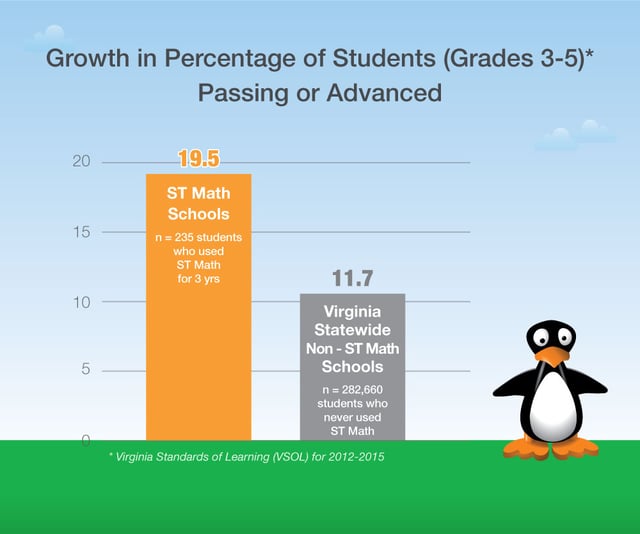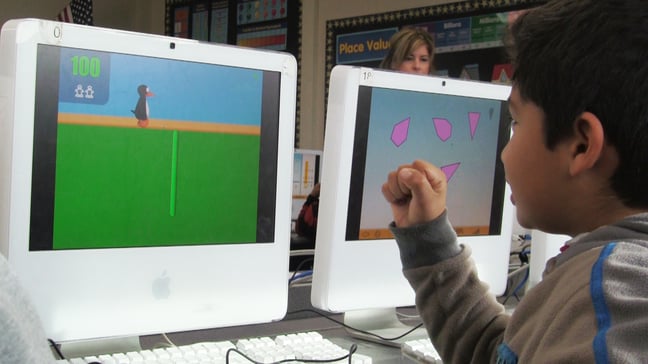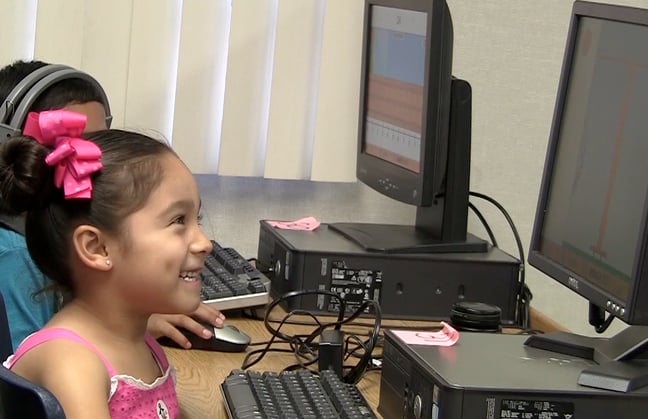
By 2025, nearly one out of every four public school students in the U.S. will be an English language learner (ELL). The call to provide equal access to effective math education for ELLs is one of the most important and challenging aspects in education today.
We've gathered thoughts from some of our superstar ST Math educators on what’s making a difference for them.
"ST Math removes the language barrier and provides access to standards-aligned content. The program replaces intimidating word problems with visual word problems that cover the same standards and students are more inclined to persevere, building their stamina in problem solving."
—Dr. Kalim Rayburn, Principal, Rea Elementary, Calif.
Albemarle County Public Schools, Va.

Albemarle County Public Schools (ACPS), nationally recognized for embracing innovative education technology, first introduced MIND Research Institute’s ST Math in 2010 as a math remediation resource for the county’s Title I schools. Their primary goal was to deepen learning for all students with a focus on their ELL population. Because of the language barrier many ELL students face, ACPS understood that they needed a unique learning experience so each student could make progress at their own pace.
"One aspect that we really like about ST Math is the non-linguistic approach,” says Matt Blundin, Lead Instructional Coach for Mathematics at ACPS. Since ST Math does not rely on language for math success, it allows students struggling with the English language to learn math by understanding concepts through visual problem solving. According to Principal Lisa Molinaro at Woodbrook Elementary, a Title I school in ACPS with a high ELL population, ST Math is the reason she has seen an increase in her students’ probability, statistics and geometry skills.
In fact, a broader analysis of Virginia Standards of Learning (VSOL) results shows that Albemarle schools using ST Math for three years are outpacing the rest of the state in math achievement.
Madison Elementary, Calif.

In 2001, Madison Elementary became one of the first schools to adopt ST Math in an effort to address the needs of their predominantly ELL students. Lisa Solomon, principal of Madison Elementary, discovered ST Math as the former principal at Martin Elementary, a school with a student population that is over 98% Hispanic, over 97% free- and reduced-lunch and over 89% English language learners. Throughout the years, she has seen the impact ST Math has had schoolwide and in individual students. The effectiveness of ST Math at Madison Elementary has been profound with an overall math proficiency increase from 54% to 79%.
“ST Math has helped us to motivate students and build their self-confidence,” says Solomon. She adds that the program makes learning fun, allows teachers to identify students’ strengths and helps build confidence. Every day she witnesses how students are excited about learning new math concepts all thanks to JiJi, the program’s lovable penguin character. Even her most struggling learners have quickly moved up the levels in ST Math, thus discovering their hidden mathematical abilities that hadn't surfaced using traditional instructional methods like textbooks. At Madison Elementary, ST Math has provided students the opportunity to be successful and has fostered a love of learning.
Pinellas County Schools, Fla.

Pinellas County Schools (PCS) is one of America’s largest districts, serving students with a wide-range of backgrounds and learning challenges. Through its “Connect for Success” program that grants laptops to Title I families and by partnering with local internet providers to offer discounted rates to these families, they were able to provide access to technology beyond the classroom. The continued ST Math learning outside of the classroom has had some outstanding results. Students who have the opportunity to work their way through more of the ST Math curriculum performed better on the Florida State Assessments than those who completed less.
Education technology should not only impact student learning but should also support the often overwhelming challenges that teachers face in providing individualized instruction for each of their students. ST Math’s instructional design does just that, according to Bryan Williams, teacher at Douglas L. Jamerson Elementary Center for Mathematics and Engineering in Pinellas. ST Math has been a powerful tool in his classroom. “With ST Math, I’ve got flexibility, and the information that the program provides really does drive my instruction.” By enhancing the math curriculum through access to technology and empowering teachers, ST Math has truly moved Pinellas closer to its goal of 100% success for all students.

Edith Esparza is the Marketing Specialist at MIND and loves sharing her passion for learning.
Comment